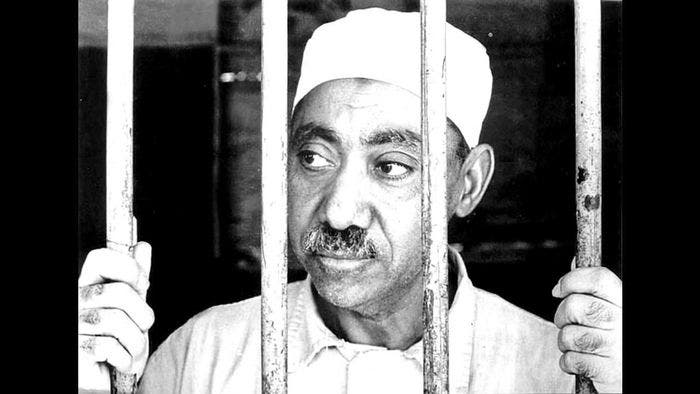Al-Arabia – In August 29, 1966, Sayed Qutb, the leading member of the Egyptian Muslim Brotherhood, was hanged to death, after he was convicted of plotting the assassination of Egyptian president Gamal Abdel Nasser.
There is no doubt that Qutb holds a prominent position in the hierarchical structure of Salafist radical Islamist groups, leading to the emergence of many offshoots of the Muslim Brotherhood, like Takfir wal-Hijra, al-Jihad movement, al-Qaeda and ISIS.
Qutb was widely regarded as the spiritual leader and the first theoretician of the revolutionary Islamic thoughts, who called for taking up arms and resorting to violence as a solution to change the existing reality. He sought to attack Islamic societies that do not apply Sharia rule and other radical thoughts.
But the status of Sayed Qutb is not limited to radical Islamist groups. He has an important place in contemporary Shiite Islamic political thought. Qutb’s preaching played an undeniable role in the formation of ideas and principles of several Shiite Islamic movements that were characterized by violence and extremism.
It is not known for certain the circumstances from which Sayed Qutb gained the principles and literature of Shiite scholars and thinkers, but it is most likely that he knew those principles through the writings of Abbas Mahmoud Akkad, and the writings of other contemporary Islamic thinkers, who read their publications during his university years at the Faculty of Science at Egypt’s Dar al-Ulum.
At the beginning of Qutb’s literary and intellectual fame among his close circles, his essays and books carried many transient references echoing his sympathy with some of the most overtly Shiite ideas.
In his book titled “Social Justice in Islam”, he sharply criticized several important Sunni figures, including Othman bin Affan and Abu Sufyan bin Harb and his son Muawiya and Amr ibn al-Aas.
In the same book, Qutb praised the Qaramita movement, which was one of the underground Shiite movements that revolted against the Abbasid Caliphate in the fourth century AH (After Hijra). Qutb described this movement as “expressing the spirit of Islam, which fights exploitation, unjust power and class differences.”
Those references by Qutb were highlighted by the Syrian researcher Mohammed Sayed Rasas in his book “The Muslim Brotherhood and Iran,” arguing that “if we delete the opinion of Sayed Qutb about the two Caliphates Abu Bakr and Omar, which the Shiites disagree with, his opinion would be in accordance with the opinion of the Shiites about Uthman and Umayyad, while his (Qutb’s) opinion on Ali bin Abi Talib also corresponds with them (Shiite).
First meeting
The first meeting between Qutb and one of the symbols of contemporary Shiite scholars, occurred in 1953, when the Egyptian intellectual received the Iranian cleric Sayed Mojtaba Mir-lohi, known as Navvab Safavi, leader of the Organization of Islamic Society, known as the “Fedayeen of Islam” or “Fada’iyan-e-Islam” in Persian.
The Syrian researcher Rasas wrote that the two men had good relations and stayed together through the time Safavi spent in Egypt, as Qutb himself arranged and supervised the Iranian cleric’s visit as he was in a leading position in the Muslim Brotherhood at that time.
The Iranian cleric and director of the Religious Dialogue Association in Iran, Hamid Gharib Reza, said that the visit had a significant impact on the Muslim Brotherhood.
He added that “Safavi had a symbolic and charismatic personality, influential in revolutionary action, and his movement was an early warning of Khomeini’s Islamic revolution.”
The greatest influence of Sayed Qutb’s thought in contemporary Shiite movements was found in the prominent Iraqi thinker Muhammad Baqir al-Sadr, and in the Shiite Dawa Party, which had many similar ideas with that of Qutb’s preaching.
Qutb’s position in the Dawa Party leadership emerged clearly during his first prison term in 1964, when Mohammed Baqir al-Sadr appealed to Iraqi President Abdel Salam Aref to mediate with Egyptian President Gamal Abdel Nasser to release Qutb, according to Saleh al-Wardani in his book “Shiites in Egypt.”
Behind prison bars
In 1969, Khomeini, the leader and inspiration of the Iranian revolution, published his most significant political book, “The Islamic Government”, three years after Qutb’s execution. This opened the door for many scholars – who studied both the men’s ideologies (Khomeini’s and Qutb’s) – to say that Khomeini might be acquainted with the writings of the Egyptian thinker, influencing his own political thinking and directing him towards establishing a religious Islamic state.
Also, the Islamic Republic issued in 1984 a postcard showing the frowning face of Sayed Qutb behind prison bars before his execution.
The current Iranian Supreme Leader Ali Khamenei is one of the most modern Shiite leaders influenced by the ideas of Qutb.
In 1966, while participating in revolutionary activities alongside Khomeini, against the Shah regime, Khamenei took the decision to establish a publishing house to publish revolutionary books that encourage the re-examination of Islam as a revolutionary trend against injustice and tyranny. Following this came Khamenei’s decision to translate Qutb’s books.
In the era of Khamenei as well, the ideas of Qutb’s radical thoughts about the selection and alienation from atheist ruling societies, will find its way into school curriculum taught to the future elements of the Iranian Revolutionary Guards.
Qutb’s biography and thoughts are still present in Iran, where intellectual meetings and scientific seminars are held, focusing on Qutb’s radical Islam. One such event was held in February 2015, and was attended by a large number of prominent Iranian thinkers.
 Shabtabnews In this dark night, I have lost my way – Arise from a corner, oh you the star of guidance.
Shabtabnews In this dark night, I have lost my way – Arise from a corner, oh you the star of guidance.



